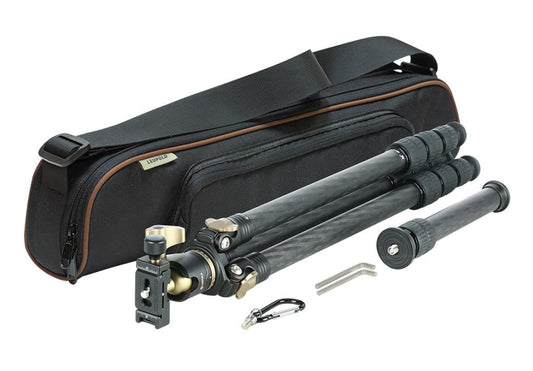

Leupold's Alpine Tripod Kit is engineered with a lightweight carbon fiber design, weighing only 32 ounces. This ensures easy transport during long hikes without sacrificing stability. Built for durability, the tripod combines carbon fiber and metal construction, allowing it to withstand tough outdoor conditions. Its adjustable height ranges from 18.5 to 58 inches, providing versatile options for various shooting scenarios.
With quick-release leg locks, setup and adjustment are straightforward, making it ideal for on-the-go photographers and hunters alike. The rubber feet provide excellent grip on uneven surfaces, ensuring stability even on rocky terrain. This tripod also features a compact design for easy storage in your backpack, maximizing your travel efficiency while keeping your equipment secure.
Key Features:
- LIGHTWEIGHT DESIGN for easy transport during long hikes.
- ADJUSTABLE HEIGHT from 18.5" to 58" for versatile shooting options.
- RUGGED CONSTRUCTION withstands harsh outdoor conditions.
- QUICK-RELEASE LEG LOCKS for fast setup and adjustment.
- RUBBER FEET provide excellent grip on uneven surfaces.
- COMPACT STORAGE fits easily in your backpack.
- STABLE SUPPORT ensures steady shots in various environments.
- VERSATILE USAGE suitable for both photography and hunting.
Technical Specifications Table
| Specification | Details |
|---|---|
| Weight | 32 ounces |
| Height Range | 18.5" to 58" |
| Material | Carbon Fiber and Metal |
| Folded Length | Compact for easy transport |
What's in the Box?
- Leupold Alpine Tripod Kit
- Carrying case
- User manual
Customer Reviews
“This tripod is incredibly lightweight and perfect for my mountain hikes. I love how stable it is!”
“I was impressed with the durability. It held up well even in windy conditions.”
“Great height adjustment and quick setup. A must-have for any outdoor photographer!”
FAQ
Many users ask about the stability of the Leupold Alpine Tripod in windy conditions. The combination of carbon fiber and metal construction provides a solid foundation, making it suitable for various outdoor environments. The rubber feet enhance grip, ensuring it remains stable even on uneven surfaces.
Another common concern is the maintenance of the tripod. Regular cleaning with a damp cloth is recommended to remove dirt and debris. Ensure the quick-release mechanisms are checked periodically for smooth operation. Users often compare it to other tripods, noting the lightweight design and durability as standout features that set it apart.
Similar Models
Looking for more options? Explore the full Leupold lineup, featuring models like the Leupold Pro Gear Tripod for a more robust build and the Leupold Compact Tripod for enhanced portability. Discover our complete collection for versatile tripods tailored to your outdoor adventures.
You May Also Like
Here’s some of our most similar products people are buying. Click to discover trending style.






